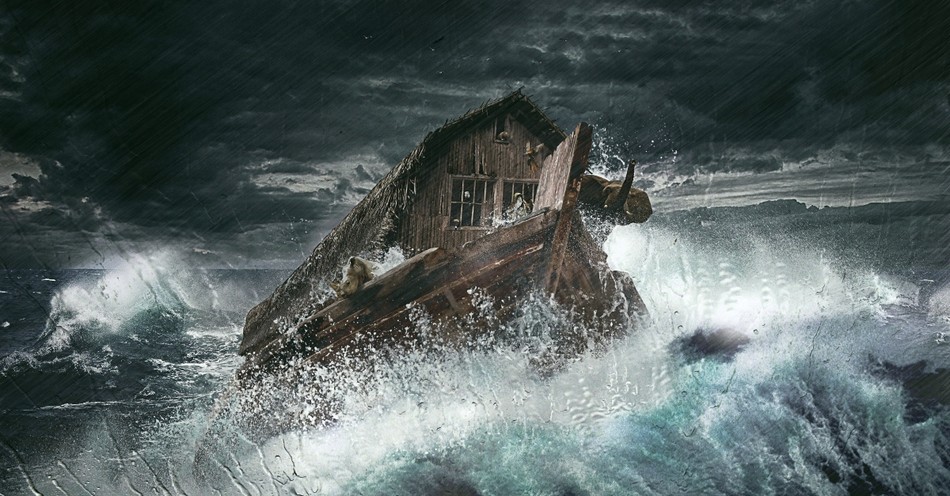The story of Noah’s Ark and the Great Flood, chronicled in Genesis 6:1 – 9:29, is one of the most iconic stories in all of history. It is also one of the most important events and turning points in the Bible. Using a cataclysmic, global flood to “blot out” all living creatures from the face of the earth, God would judge creation for the wickedness and depravity of humanity. However, in His grace, God would offer salvation to a single family and two of every living creature via the ark, starting civilization anew through a family whose head was “righteous” and “blameless in his time” (Genesis 6:9). We know this figure as Noah.
But when was the Great Flood exactly?
Unfortunately, the Bible does not give us the exact day, month, or year of the Great Flood. However, that does not mean its place in history is a complete mystery. The Genesis account provides incredible details as well as some key evidence that might help us arrive at an approximate date for the Flood. In fact, a historical view of Genesis, including the Bible’s account of the Great Flood, points to an actual global event that happened sometime around the year 2348 B.C., roughly 1,656 years after God created the universe.
Was the Biblical Flood Actual History?
Drawing any conclusions about a date for most events described in the first eleven chapters of Genesis requires a commitment to the belief that these events, including the Flood, actually happened.
After all, it is not uncommon to encounter scientists, scholars, skeptics, and even church leaders who profess that the biblical flood was not an historical event, but rather, an ancient myth, historical fiction, or some other form of epic poetry. This is an argument that has proliferated through academia, the sciences, and even the church over the last two hundred years and is often presented in tandem with the view that the earth is millions and millions of years old.
However, for most of church history, Christians almost universally accepted that the biblical account of the Great Flood described an actual year-long, worldwide disaster of supernatural origins. In fact, there is good biblical, scientific, and archeological evidence to continue to support this position.
At the very least, the biblical authors, in both the Old and New Testaments, viewed Genesis and the Flood as actual history, not Jewish mythology. They also regarded Noah as a real, historical figure and the ancestor of major characters in both testaments, not just a fictional hero or Jewish archetype (see Matthew 24:37-39; Luke 3:23-28; 1 Peter 3:20; 2 Peter 2:5; 3:3-37; Isaiah 54:9; Ezekiel 14:14).
The Genesis account of the Flood also does not incorporate the same poetic devices of similar myths and legends. In fact, with the exception of the Babylonian Epic of Gilgamesh, the biblical flood predates other flood narratives, which were recorded long after Genesis was written.
Furthermore, the first eleven chapters of Genesis are written in a language that reads far less like epic poetry or myth and more like a literal, historical account of the events and generations between Adam (the first man) and Abraham (Genesis 12) as Moses, the author of Genesis, intended.
In addition, modern science and even contemporary archeology routinely validate what the Bible has proclaimed all along. The pages of Scripture, even early Genesis, are far more consistent, reliable, and historical than our skeptical world often cares to admit.
When Did the Great Flood Happen?
There are two ways to approximate a date for the biblical flood. We can either start from the beginning of creation or work our way backwards from later events in Scripture. Using either approach, we can estimate that the rains of the biblical flood began around the year 2348 B.C., or roughly 1,656 years after creation.
But how do we arrive at these dates?
Let’s start with what Genesis tells us.
The biblical account of the Flood begins in the sixth chapter of Genesis. Here, the Bible tells us that “the wickedness of man was great on the earth, and every intent of the thoughts of his heart was only evil continually” (Genesis 6:5). The author of Genesis (Moses) goes on to reveal that “the earth was corrupt in the sight of God, and the earth was filled with violence.” (Genesis 6:11)
Accordingly, God decided that He would judge creation by “blotting out” all living things from the face of the earth using a worldwide flood (Genesis 6:7;17).
However, God would choose to spare Noah and his family, along with two of every living creature, by having Noah build a giant boat (the ark) to escape the coming rains. With Noah, who God regarded as “righteous” and “blameless in his time,” God would start civilization anew and establish a covenant with Noah, his sons, and their descendants (Genesis 6:18). “Thus Noah did according to all that God had commanded him.” (Genesis 6:22)
The Bible then tells us that “Noah was six hundred years old when the flood of water came upon the earth” (Genesis 7:6; emphasis added).
While significant, Noah’s recorded age does not tell us when the Great Flood actually began. All it reveals is how old he was at the time. For more detail, we have to go back to the previous chapter where we find the genealogy of Adam (the first man) up to Noah (Genesis 5).
Thankfully, this early genealogy provides the ages of Noah’s ancestors when they died, as well as how old they were when their sons and heirs were born. This is critical information.
Of course, the exact calendar system of Noah’s day is unknown. However, we have no reason to assume that the “days," “months,” or “years” mentioned in Genesis do not align with the Jewish calendar of Moses’ day.
The Genesis 5 genealogy, therefore, offers the following timeline to consider:
- God creates the heavens and the earth; time as we record it begins (Genesis 1-2).
- Adam becomes the father of Seth at the age of 130 (Genesis 5:3).
- Seth becomes the father of Enosh at 105 (Genesis 5:6).
- Enosh becomes the father of Kenan at 90 (Genesis 5:9).
- Cainan becomes the father of Mahalalel at 70 (Genesis 5:12).
- Mahalalel becomes the father of Jared at 65 (Genesis 5:15).
- Jared becomes the father of Enoch at 162 (Genesis 5:18).
- Enoch becomes the father of Methuselah at 65 (Genesis 5:21).
- Methuselah becomes the father of Lamech at 187 (Genesis 5:25).
- Lamech becomes the father of Noah at 182 (Genesis 5:28).
Starting with zero (the beginning of creation), we can add up the ages of each of Noah’s ancestors at the time their recorded heir was born.
David Wright at AnswersinGenesis wisely reminds us that, “since the Bible does not provide the number of months in the age of each patriarch listed from Adam to Noah, then we could add about five more years to this number… on average, there would likely be an additional six months for each generation.”
That considered, if we follow the Genesis account, trusting that Noah was in fact 600 years old when he and his family entered the ark, we arrive at the year 1656 A.M. (Anno Mundi – “year of the world”) as the year of the Great Flood.
This also means that the Great Flood began roughly 726 years after the death of Adam.
Of course, historians today rarely record dates using A.M., but rather, the B.C. calendar. Can we know, therefore, what year (B.C.) the biblical flood happened?
That answer is a little more complicated and depends largely on one’s view of creation and the age of the universe. Here, we are required to work backwards from the present.
Despite the claims of evolutionists, the Bible does not seem to support a view of the earth or universe that is millions of years old or the position that humanity first arrived on the scene 40,000 to 600,000 years ago. Instead, a more historical view of Genesis supports a much younger universe, perhaps closer to 4,000 to 6,000 years old.
It is worth noting, however, that many “Old Earth” creationists believe that gaps, names, and entire generations may be missing from the Genesis genealogies, which would add years to the overall age of the earth. But again, not all scientists, or even historians and creationists, agree on the exact age of the universe or the chronological timeline of Genesis (see The Annals of the World by James Ussher, Newton’s Revised History of Ancient Kingdoms, or Chronology of the Old Testament by Dr. Floyd Nolen Jones).
However, if we believe that the genealogies of Genesis 5 and 11 are literal, unbroken, and chronological, as many creationists do, we can calculate that the start of the Flood happened around 2348 B.C.
Added up, the years provided in Genesis chapters 5 and 11 account for about 2,000 years between Adam and Abraham, with biblical and historical evidence placing Abraham (Genesis 12) at about 2000 B.C.
According to the Hebrew Bible, the actual age of the universe would be a little more than 6,000 years old, with the biblical flood happening around 4,000 years ago.
When Did Noah Build the Ark?
If we believe 2348 B.C. was the start of the biblical flood, we can then draw a few more conclusions about the Genesis timeline.
One question about the Flood many asked over the years is: how long did it take Noah and his family to build the ark?
The structural details for the ark, provided by God in Genesis 6:14-16, reveal a vessel of considerable size. This was obviously a sizable project for Noah, his sons, and whoever helped them build the ark. The ark had to be big enough to house two of every living creature on the earth, strong enough to survive 40 continuous days of torrential rainfall, and seaworthy enough to remain afloat for over a year. It is safe, therefore, to assume that the ark was probably not built in a day.
So, how long did it take?
Unfortunately, a common misconception about the building of the ark comes from the early verses of Genesis 6: “Then the Lord said, ‘My Spirit shall not strive with man forever, because he also is flesh; nevertheless his days shall be one hundred and twenty years.’” (Genesis 6:3)
It is understandable why some might equate 120 years with Noah’s construction of the ark. After all, it is only a few verses later that God turns His attention to Noah and commissions him to begin work on the ark (Genesis 6:13).
However, all we really learn in Genesis 6:3 is that 120 years was the span of time until the Great Flood began. Accordingly, mankind had been given the opportunity (and time) to respond to God’s warning and repent before the floods came (see 1 Peter 3:20). Even after Noah and his family entered the ark, God would tarry an additional seven days (see Genesis 7:4). As 2 Peter 3:9 reminds us, “The Lord is not slow about His promise, as some count slowness, but is patient toward you, not wishing for any to perish but for all to come to repentance.”
That being said, one thing is as true today as it was in the days of Noah: God will not remain patient forever. His righteous judgment will eventually be poured out on unrepentant sinners.
So, if it did not take Noah the full 120 years to build the ark, how long did it take?
One clue is found in the second genealogy of Genesis, which reveals that Shem, Noah’s son and heir, was one hundred years old when he became the father of Arpachshad “two years after the flood” (Genesis 11:10; emphasis added).
We can assume, then, that Shem was 98-99 years old when the Flood began (2348 B.C.).
Genesis 6:9 also informs us that Noah already had sons (Shem, Ham, and Japheth) at the time God commissioned him to build the ark (Genesis 6:10) and those sons had wives when God selected Noah and his family to be the remnant of creation and instructed them to enter the ark (Genesis 6:18; 7:7).
Of course, we don’t know how old Shem was when he married. Assuming, however, that he was anywhere from an adolescent to somewhere in his twenties or thirties when he married his wife, we can conservatively estimate that Noah and his sons (and perhaps others) began work on the ark roughly 80 years (or less) before the rains came.
How Long Did Noah and His Family Stay on the Ark?
From the beginning of the Flood to the moment Noah, his family, and the animals disembarked from the ark was a period lasting a little over a year (see Genesis 7:11; 8:14).
We get this straight from Genesis. The timeline for the Flood then follows:
- In the 600th year of Noah’s life, in the 2nd month, on the 10th day of the month, Noah, his family, and the animals enter the ark (Genesis 7:4, 10-11).7 days later, the Flood begins (Genesis 7:11).
- The rains come and water floods the earth for a period of 150 days (5 months, 30 days in each month), including the 40 day and 40 nights of continuous torrential rain (Genesis 7:12, 17, 24; 8:1).
- After the period of 150 days, the waters covering the earth begin to recede steadily (Genesis 7:24; 8:1-3).
- In the 7th month, on the 17th day of the month, the waters recede enough for the ark to rest on the top of Mt. Ararat in what is present-day Turkey (Genesis 8:3-4).
- It takes an additional 74 days for the tops of additional mountains to be seen (Genesis 8:5).
- 40 days later, Noah sends a raven and a dove to search for dry land (Genesis 8:6).
- Over the next 14 days, Noah sends out two more doves (Genesis 8:10, 12).
- By Noah’s 601st year, in the 1st month, on the 1st day of the month, the waters that once covered the entire earth have dried up (Genesis 8:12-13).
- Noah waits an additional month and 26 days before disembarking from the ark with his family (Genesis 8:14).
From these details, therefore, we are given a timespan of roughly 370 days that Noah and his family remained on the ark. And after a little over a year, the survivors of the Great Flood disembarked onto dry land to start civilization anew.
From all the information gathered, we can estimate this happened around the year 2347 B.C. It is not an exact date or perfect conclusion. However, the details provided in Scripture do support a historical view of the Great Flood that places it around this time period.
Additional Resources:
“Who Was Noah in the Bible?”
“Noah’s Ark and the Flood – Bible Story
“How Old Was Noah When He Built the Ark?”
“A Flood of Evidence: Chronological Snobbery and Archeology”
“How Old is the Earth and is it Important to Know the Exact Age?”
“Why Did God Flood the Earth?”
“How Old Was Noah When He Died?”
“Why Did People in the Old Testament Live so Long?”
Photo Credit: ©iStock/Getty Images Plus/Pink_frog




